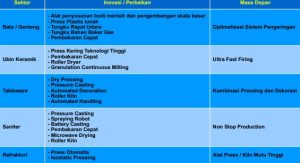Hello, physicist!
Jendela Rumah Kita is an ongoing event organized by Physics Department, Diponegoro University and is a Teaching Physics Alumni program in facilitating physics students in particular to gain knowledge through the stories of great speakers from alumni and other great figures. Jendela Rumah Kita series 9 discusses the Research and Innovation of Ceramic Materials with Mr. Totok Nugroho, S.Si.
About Source
Totok Nugroho S.Si is an Alumnus of Physics, Diponegoro University in 1988. He began his career as the main engineer of the National Research and Innovation Agency from 2015 until now. He attended Klin and Firing Technology Nagoya Japan in 1999 and Ceramics Raw Material Characterization,Palermo, Italy in 2001.
Ceramics Industry
The development of terminology about the green economy means the need for the return of products to the initial material that has become waste. Advanced ceramic is still constrained in Indonesia let alone the existence of market competition.
Research and Innovation
Research is research, derived from the words re and search,looking for something new to be the essence of the word research,how we look for something new, look for something behind events, phenomena or find a solution through research or research. Innovation is a process to realize, combine, or mature a knowledge / idea of ideas, which is then adjusted to get new value of a product, process, or service.
Classification of Ceramic Materials
Ceramic materials are divided into 3, namely ceramics, metals and polymers. Ceramic materials have advantages including heat resistance, corrosion resistant and not conducting electricity but the deficiency is easily broken. Polymer materials have the advantage of being easy to form but not heat resistant while metal materials are heat resistant but easily corroded. Not infrequently there is a so-called composite, which is a material that takes the best part of each or part of the material. Ceramics according to ASTM(American society for testing of materials)is a welded or unslded item that has a crystalline atomic structure (regular), partially organized (semi-crystalline) or irregular(amorphous / glass), where the body is made of inorganic nonmetallic material, or can also be formed from a melting mass then undergoing a compaction process at the time of cooling, or formed simultaneously (simultaneously) then matured by heat treatment.
Advanced equipment in the world of Ceramic research
- Scanning Electron Microscope
- Transmission Electron Microscope
- X-Ray Difractometer
- X-Ray Fluoroscence
Difference between advanced ceramics and knventional  ceramics Innovation and Development of ceramic industry and future development.
ceramics Innovation and Development of ceramic industry and future development.

Obstacles in the development of Indonesia’s ceramic industry
- Raw Materials
Inconsistent and there is no material refining industry. Such large deposits have not been professionally managed, except: kaolin and clay. Quality inconsistencies force manufacturers to import raw materials:
- Ceramic Frit – 50-60% import
- Dyes – Almost 100% imported
- Zirconium Silicate – 100% imported
- Feldspar – above 50% of imports
- Human Resources
- Less Ceramicists
- Lack of Ceramic Education Institutions
- Milieu
- Wastewater Countermeasures
- Waste Material Countermeasures
- Energy Availability
Based on these things, it needs to be developed and become a challenge in the world of research, namely how ceramic composites are created to determine the best quality of ceramics.

